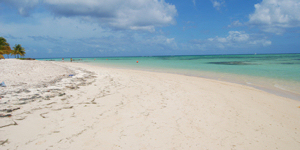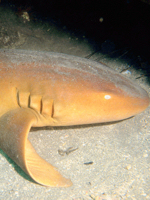Learning to dive in Tobago
With its coconut palms and white sand beaches, Tobago is the quintessential Caribbean island. In its cerulean waters are some of the world’s best diving sites replete with marine life. Ruth Styles is keen to take the plunge but faces one small problem: a fear of fish.
Tucked away behind its larger sister island of Trinidad, Tobago is a classic Caribbean paradise, complete with swaying coconut palms, crystal clear waters and miles of bleached white sandy beaches. But the island has more to recommend it than pretty beaches. Thanks to nutrient-rich currents from the mouth of the Orinoco River, Tobago’s waters are alive with large colourful sponges, sharks and abundant fish. It was the latter that preyed on my mind the most as I prepared to take the leap off the boat.
In at the deep end
I was in Tobago for a four-day PADI dive course staying at the luxury Magdalena Grand Beach Resort in Little Rocky Bay. On our first morning, we wandered down to the hotel’s World of Watersports dive centre to meet boss Sean Robinson, our dive teacher.
 Magdalena Grand Beach Resort in Little Rocky Bay
Magdalena Grand Beach Resort in Little Rocky BayManty Atherton
Resplendent in a lime green t-shirt, he was full of diving anecdotes, as well as graphic descriptions of a serious diving hazard known as the bends or decompression sickness. This occurs when a divers ascends too rapidly to the surface and can be fatal. After a couple of hours spent listening to Sean, I felt even more terrified.
Before panic could set in, I was diverted by a hugely unflattering wetsuit being proffered in my direction. Togged up in an ugly expanse of neoprene, a hefty weight belt and an inflatable jacket, I staggered over to the training pool to meet our second instructor; Mutley (real name, Leslie James) had the size and demeanour of a nightclub bouncer, complete with a gold tooth that flashed every time he smiled. He didn’t do it often.
Out on the reef
After two days of pool training, we were ready for our first open water dive. One of the most beautiful spots on Tobago is Pigeon Point in the south of the island boasting white sands, palm trees and azure waters. Just offshore lie the enormous Buccoo Reef and the smaller Kariwak Reef, both of which lurk 5m (15ft) below the water. This is where we headed.
 Sublime Pigeon Point
Sublime Pigeon PointCreative Commons / Paul Mannix
After Mutley prised my fingers from the side of the boat, I followed my two fellow students into the water and down towards the seabed. As I hauled myself down the anchor chain, hazy shapes swam into view before a multicoloured parrot fish burst out of the gloom towards me. Mutley was waiting on the seabed, arms folded, doo-rag hat and gold tooth intact.
Waving us forward, we headed out towards the reef where a bizarre underwater forest unfolded in front of our eyes. A pilot fish quickly attached itself to Mutley. I backed away hastily only to be confronted by our other diving instructor, Tooley, dragging a moray eel out of its cave by the tail. It looked furious and I felt queasy. He gave me a thumbs up and we swam on. Shoals of tiny black and white fish surrounded us, while bigger yellow fish drifted lazily by. By the end of the first dive, I had relaxed. The fish didn’t seem to see us as any more of a threat than a piece of driftwood, scattering as we swam past and reforming into moving clouds behind us. They definitely weren’t interested in attacking me – not even the stingray I saw. And amazingly, not even the sharks.
Shark! Shark!
Although no two reefs are ever the same, some things are universal. During my dives, what really struck me was just how much life there was below the waves. Trailing fronds of seaweed hid tiny black and white striped fish, while concealed in the sand at the base of the reef lay speckled sting rays and moray eels. A tiny pink and purple prawn made its jerky way past, only to be swept up by Mutley for a closer look.
 A nurse shark
A nurse sharkPhotos.com / Jupiterimages
At Japanese Gardens, a green turtle made a lazy loop around us and hidden under a rock, we found a nurse shark taking a nap. All I could see was a triangular fin poking out of the sea cave, looking for all the world like another ray. Then I realised what it really was: a 1.5m long (5ft) grey killing machine. ‘Shark! Shark!’ I tried to scream, thrashing frantically as I tried to swim away. Mutley shook his head wryly. The shark slept on. I lived to dive another day.
But it wasn’t the big beasts that made the most striking impression: it was the shoals of rainbow coloured fish swirling around us in all directions. As a diver, you’re part of their world – a fact that became abundantly clear when a tiny pilot fish started following in my slipstream. Surfacing after the third dive, I felt euphoric. I hadn’t been eaten by a shark and I’d seen plenty to love. I’d even managed to acquire my dive certificate in the process. Tired but elated, I decided to treat myself to a bit of island nightlife.
A bottle of rum...
I’d steered clear of alcohol during my training course after apocalyptic warnings from Sean on the dangers of drinking and diving (“most dead divers have more alcohol in them than in a bottle of wine,” he’d said). By the time the course finished, I was more than ready to sample the local nightlife and that meant Sunday School. Situated in a car park in Buccoo Village, accompanied by throbbing reggae and industrial quantities of rum, I partied hard until the early hours of the morning. Luckily, the next day involved nothing more onerous than a boat trip.
Natural spa
 A waist-deep pool in the middle of the ocean
A waist-deep pool in the middle of the oceanCreative Commons / Paul Mannix
We took a glass bottom boat over to Buccoo Reef and the utterly lovely Nylon Pool. A shallow bowl of water sandwiched between the ocean and a palm fringed beach, the Nylon Pool is a natural wonder that’s perfect for a dip. The mineral rich sand at the bottom is used by local spas as an exfoliant but you can scoop up handfuls and slough off dead skin for free while you’re there. After a swim, lunch, in the form of a beach barbecue, was served on the beach. Snorkelling was also on the menu if but after four days of diving, I wanted to eat the fish much more than I wanted to look at them. Luckily for me, in Tobago, you can do both.
FACT BOX
A week’s B&B stay at the 4-star Magdalena Grand Beach Resort on Tobago with Golden Caribbean (tel: 0845 085 8080; www.goldencaribbean.co.uk) starts from £786pp (based on two sharing), and includes return Monarch Airlines flights from London Gatwick and transfers, departing 20 February 2013.
Padi Open Water Certificate, including four open water dives, all instruction, boat transport and equipment hire, starts from £395pp. To book, see www.worldofwatersports.com.
Do you have any Feedback about this page?
© 2026 Columbus Travel Media Ltd. All rights reserved. No part of this site may be reproduced without our written permission, click here for information on Columbus Content Solutions.









 You know where
You know where